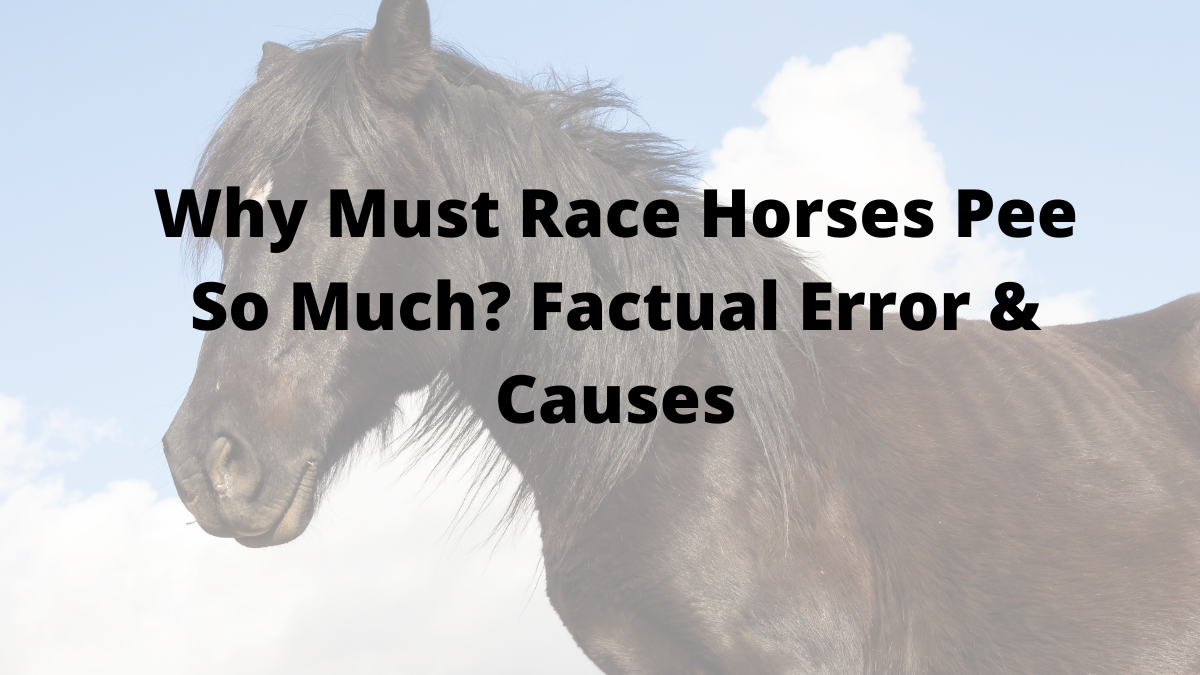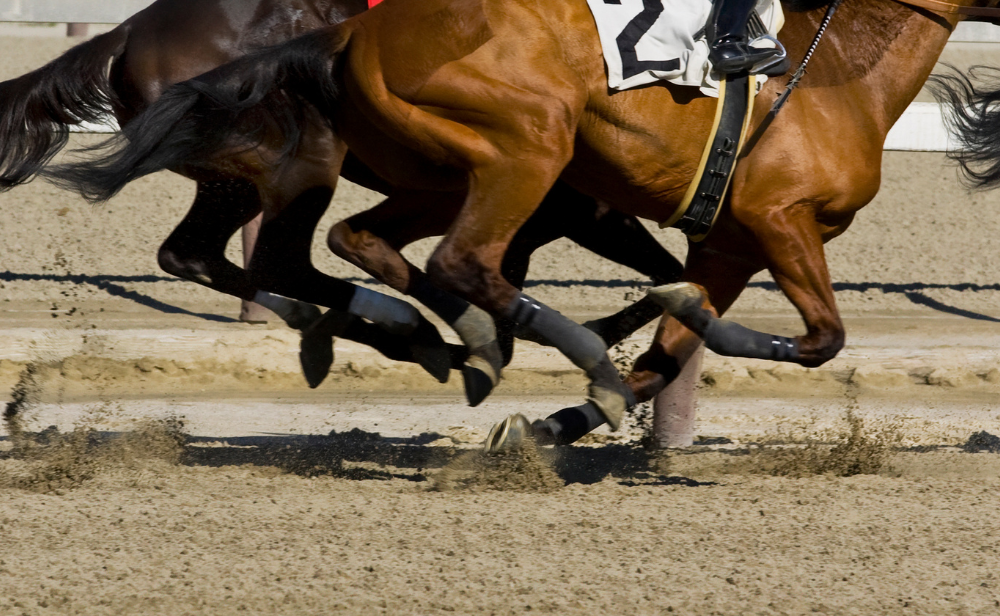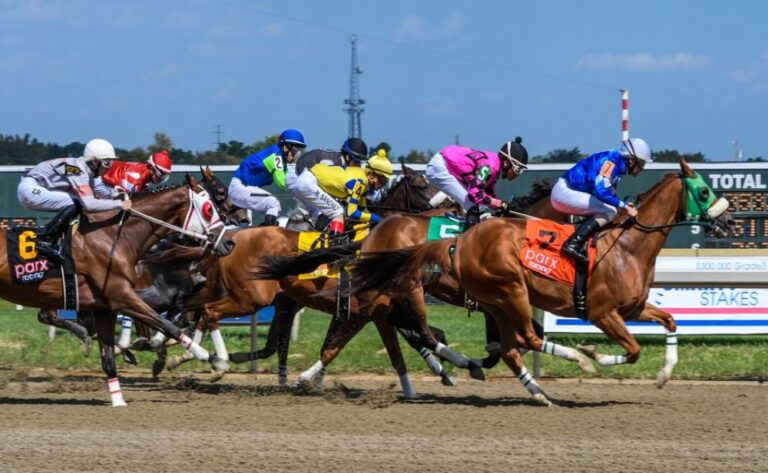Why Must Race Horses Pee So Much? Factual Error & Causes


If you’ve ever been to a racetrack, you’ve probably noticed how frequently the horses urinate. Why do racehorses urinate so frequently? The information presented here is based on research I conducted despite believing I already knew the answer.
Because racehorses receive an injection of the diuretic medicine Lasix just before a race, they must urinate frequently. Within an hour following injection, many gallons of pee flow from the horse’s bladder due to Lasix’s ability to attract fluids into the bladder.
Although not the only factor, Lasix is the principal cause of a racehorse’s excessive urination. Let’s explore this fascinating subject in greater detail.
On average, horses excrete 2.5 litres of urine per day.
The recommended daily urination rate for horses is 0.3 fluid ounces per pound of body weight. This equates to around 2.5 gallons daily for a horse of average size.
However, the volume of pee varies according to the horse’s size, age, amount of fluid consumed, weather, and feed. A healthy horse should have clear urine, a slightly golden hue, and little to no odour. A horse should be able to urinate quickly and continuously.
A crucial physiological function is a urination. It helps the body eliminate waste while affecting blood pressure and electrolyte balance. Contact a veterinarian immediately if your horse isn’t generating any pee or is having trouble urinating. There are some potentially fatal reasons for urine retention in horses.
Horses urinate when on Lasix.
Horses are administered Lasix to stop respiratory bleeding brought on by strenuous exercise. A horse pumps enormous volumes of blood into the arteries surrounding its lungs during racing.
Capillaries might burst due to the intense pressure brought on by blood pumping through blood arteries and air entering the lungs. Blood enters the lungs as the barrier is breached, leaving the horses’ nostrils as it does so.
Exercise-induced pulmonary bleeding is the medical phrase used to describe this event (EIPH). Chronically present conditions can cause inflammation, reduced lung function, or, in extreme instances, even death.
According to estimates, most racehorses are said to bleed to some extent, albeit not all of these bleeds will come from the nose.
Many times, horse trainers misuse Lasix.
When used on the racetrack to compel a horse to urinate rather than to reduce bleeding, Lasix can be abused. Trainers are constantly seeking methods to give their horses an advantage; many think giving them a Lasix injection will do just that.
Lasix makes a horse release fluid, which reduces weight. Lasix is injected into horses by their trainers to help them carry less weight during a race. After taking a dose of Lasix, it is thought that a horse may lose 10 to 15 pounds of fluid in an hour. Please read our article to learn how much weight a racehorse loses during a race.
Lasix usage is decreasing at several racetracks.
On daily racing forms, it is stated which horses are using Lasix. The public who bets on horses uses these forms to guide them in selecting which horses to wager on. Lasix administration is taken into account by gamblers. Thus it follows that Lasix is affecting a horse’s ability to race.
A group of actual racetracks will begin gradually banning the use of Lasix on race days in 2020. The horse deaths at Santa Anita brought about the ban. The prohibition on treating racers under the age of two with Lasix twenty-four hours before their race will be the first phase of the phase-out. To read an article we wrote regarding racehorse fatalities, click the link.
The prohibition will be extended to all horses competing in any stakes race on the self-restricting tracks in the second phase, which will take effect in 2021. Churchill Downs, Pimlico, and Belmont are a few of the coalition’s more well-known racetracks.
You can read our post here if you’re interested in knowing more about stakes races. The American Quarter Horse Association (AQHA) is looking at Lasix to decide whether to restrict or forbid its use at upcoming AQHA horse shows.
Racehorses don’t urinate more frequently than ordinary horses.
If you watch many racehorses urinate while at the races, you might wonder if they pee more than other horses.
Horses of all breeds urinate equally frequently. The difference is that racehorses use Lasix, which makes them urinate abundantly. Lasix is used in equestrian competitions besides racing.
Horses’ bladders are enormous.
The bladder of a horse has a capacity of three to four quarts. A horse’s bladder can produce stones. Calcium concentrations are what cause bladder stones.
The most typical indication that a horse has bladder stones is post-exercise blood in the pee. Keep an eye out for any telltale signs of stress in your horse because these could be colic symptoms. Males are more likely to get bladder stones because they have longer urinary tracts.
Infected cells frequently lead to bladder stones. Mineral deposits cover the cells in layers to the point where they resemble stones. Bladder stone development is influenced by diet.
Calling your veterinarian to get a diagnosis confirmation is necessary if you think your horse has bladder stones. Ultrasound or endoscopy are used to make diagnoses. Surgery is needed to treat a horse who has developed severe bladder stones.
Keep in mind that the best medication is prevention. Keep your horse well-hydrated by ensuring that he consumes the appropriate amount of water for the surroundings in which he is housed. If your horse doesn’t drink enough water, consider putting a supplement in the water to make it taste better. A healthy horse needs to stay hydrated.
What does it mean to “poop like a Russian racehorse”?
The saying “pee like a Russian racehorse” was something I frequently heard growing up with three brothers. Even though I was never clear if they meant “Russian” or “rushing racehorse,” I decided to learn more about this expression.
Before a race, racehorses experience anxiety and exhibit hurrying behaviour. The horses are led into the paddock for mounting after being paraded in front of the grandstands. The racehorses urinate frequently and heavily as they move tensely in front of the audience. Racehorse from Russia is absurd.
As the use of Lasix increased, racehorses were more likely to empty their bladders just before a race. So it makes sense when someone says, “I have to pee like a galloping racehorse,” when they have an urgent urge to urinate.
Horse racing prohibits the use of steroids.
Anabolic steroids, peptide hormones, growth factors, beta-2 agonists, hormone and metabolic modulators, and certain diuretics are prohibited at most horse racing facilities.
In light of the recent spate of fatalities at Santa Anita, performance-enhancing medications are a hot topic. The people who work in the horse racing sector want to reduce the frequency of deaths among horses. However, no single regulatory organization has the authority to enforce drug laws on all American tracks.
The Racing Medication and Testing Consortium (RMTC) has set rules for the United States. The policies cover testing, fines, and prescription regulations. Additionally, RMTC restricted the use of Lasix by creating a controlled substance list.
On their website, the Racing Medication and Testing Consortium provide more information. A list of substances forbidden for usage on horses competing in quarter horse races may be found on the American Quarter Horse Association website.
In a race, how much weight does a horse loose?
It was probably on a hot day if you’ve ever attended a horse racing in Louisiana. Running horses in the scorching Louisiana sun lose a lot of weight. They are large animals that strain their physical limits. So let’s examine some figures and information regarding the weight that a racehorse will shed throughout a race.
In a one-mile race, a horse can lose up to 5% of his body weight; for a Thoroughbred of average size, this equates to more than 50 lbs. In a race, fluid loss makes up most of the weight loss.
When horses exercise regularly, they burn a lot of calories and lose a lot of fluid, but the amount of weight they lose is astonishing.
Horses’ weight loss during a race
Most of a horse’s weight loss in a race is fluid loss. Heat is produced by a horse’s body, which leads to sweating. Some investigations have verified fluid losses of 4–7 per cent of body weight following a mile run.
Temperature, humidity, and race length affect how much fluid and electrolyte are lost throughout a race. To avoid getting sick, horses need to be well hydrated before races and then replenished afterwards.
High fluid losses raise the animal’s risk of being dehydrated, which in horses causes an unsafe loss of electrolytes and increases core temperatures.
While electrolyte supplements are required to assist replace the electrolytes lost during a race, water is unquestionably the essential food for overheated horses. You can get Farnam Apple Elite Electrolyte, a quality equestrian supplement, on Amazon. Check out their prices by clicking here.
When Will a Racehorse Regain the Weight, He Lost During a Race?
Of course, the amount of sweat a horse produces during a race depends on the temperature, humidity, and fitness level. The racehorse should be able to regain the lost weight in two to three days if he is at the height of his physical fitness. Some horses can fully recover from a race within 24 hours.
How Much Does a Racehorse Weigh on Average?
It is challenging to ascertain a racehorse’s typical weight because the tracks do not demand it. The regular thoroughbred racehorse weighs 1150 pounds, though. Trainers keep an eye on racehorses to establish their ideal race weight.
While some trainers utilize scales, much work with their horses daily and use their extensive horse expertise (judgment of the eye) to check their fitness.
Trainers who have scales weigh their horses before and after exercises and races and record the data. Weighing a horse replaces guesswork with data, but even with rankings, determining a horse’s peak fitness level isn’t a precise science.
Horses are individuals, like people, and success depends on various circumstances. Knowing your horse and how his physique naturally changes over time is the key.
What Weight Should A Baby Horse Have?
According to basic guidelines, the newborn foal should weigh roughly 10% as much as the mother. The offspring of a mother weighing 1,000 pounds should therefore weigh 100 pounds. This applies to all breeds.
It is easiest to weigh yourself first, lift the foal, and go onto the scales before considering a newborn. The foal’s weight makes a difference. A newborn’s weight has never depended on the foal’s gender.
A colt and a filly ought should weigh the same. If a foal is born earlier than the typical 340-day gestation period for horses, it may be smaller than usual.
Call your veterinarian right away if you think your foal was born prematurely. Within two to three hours of birth, a healthy foal should be able to stand and start nursing.
How Much Does a Thoroughbred Weigh on Average?
A mature 5-year-old thoroughbred typically weighs 1,256 pounds. Although thoroughbred horses continue to develop until they are five, this does not always indicate that they continue to gain weight.
Some horses could weigh more at age two than they do at age five. Horses become leaner when additional muscle replaces their body fat. A horse’s size and shape are influenced by genetics, training, feeding habits, and environment.
How does a Horse’s Weight Change While Traveling?
An essential factor in a horse’s weight loss is travel. When being transported, horses frequently forgo eating and drinking as much as usual. This results in weight loss.
A horse typically loses weight when travelling a greater distance for competition. Less experienced horses are more impacted by travel than more seasoned ones. After a race, a young horse is prone to stop eating.
Plan to keep your horse hydrated while travelling; this may necessitate frequently stopping so the horse may get out of the trailer and walk. Knowing his horse well will help a trainer make the best plans.
Some horses find it more comfortable to travel with a canine companion or a stablemate. It should be done whatever it takes to maintain a horse healthy when travelling.
Can Losing Weight Indicate Trouble?
Yes, weight loss can signal a possible issue before other symptoms become apparent. Some of the most frequent causes of a horse losing weight are:
Causes of a horse’s weight loss
Diet
Even if a horse consumes his usual quantity of hay and feed, he may lose weight. The first factor to consider is a change in the grass and feed quality.
It frequently happens to receive a shipment of poor hay; even when bought from the same distributor, the grass is not all created equal. Feed is no different. The nutritional requirements of the horses also alter over time.
To assist the horse in maintaining a healthy weight, it can be required to supplement the feed with vitamins and minerals.
Disease
Consider an illness as the possible cause of the weight loss if your horse is eating well but still losing weight. Low levels of albumin were found in blood tests of horses that lose weight while consuming typical healthy meals.
The liver produces albumin, which aids in the transportation of hormones and other substances. Low albumin may indicate issues with the bowels, kidney, or liver. This problem should be addressed by a veterinarian right once because it could result in significant health problems or even death for your horse.
Dental Issues
Regular examination and flotation of horse teeth are required. Horses can develop various dental issues in their mouths that impair chewing and digestion. In an otherwise healthy horse, weight loss is caused by dental problems.
Parasites
Horses need to be dewormed regularly. Internal parasites can harm a horse’s organs in addition to causing weight loss. To view the Ivermectin Paste Dewormer pricing available on Amazon, click here.
In addition to annoying horses, flies and mosquitoes can spread disease. (To read our article on horseflies, go here.)
A Cold Climate
Horses use more energy to stay warm during colder weather than they do during warmer weather. Even if they continue to consume the same quantity of feed and hay, they lose weight because they have to use more energy to stay warm.
To account for the additional energy needed during cold weather, increase the feed and hay they consume daily.
Heat Wave
In warmer conditions, horses will also lose weight. Heat plus pests are a recipe for a horse’s stress, hair loss, and weight loss. Install a fan in the barn to keep the air moving if the horse is kept in stalls.
One way to keep the animal calm and some flying insects off the horse is to move the air about.
Rank Order
If you own more than one horse, the bully will probably exist. Unless the horses are kept apart during feeding times, the weaker horse will be denied access to his feed.
Feeding the horses individually will allow you to keep track of each horse’s food intake if you detect a problem.
What Is a Horse’s Ideal Weight?
The Henneke Body Condition Scoring System was created by Don Henneke, PhD, as a collection of visual and tactile tests to gauge a horse’s body fat (BCS).
It is frequently employed by some law enforcement when determining whether horse abuse or neglect has occurred. The BCS uses the Henneke Chart to standardize the scoring methodology and apply objective criteria.
Six areas of a horse are examined by the Henneke Body Condition Scoring System: the neck, withers, shoulder, ribs, loin, and tailhead. You must firmly press on the body to inspect the locations.
You must be able to feel the fat covering the bones when you press on the ribcage and estimate how much fat is present. The withers should feel like you are squeezing hard clay in your hands when you touch them.
You assign a number to the horse’s condition in each of the six areas as you check each one. You add the numbers together and divide by six once you have a number for each location.
The animal’s Henneke Body Scoring Condition is indicated by this number. A scale from 1 to 9 is used to determine the score. One is thought to be emaciated and has no body fat, whereas nine is obese. A score between 4 to 7 is considered acceptable, with a five being optimum.
Any breed of horse can have its ideal weight determined using the BCS. (More information about the Henneke Body Scoring Condition can be found here.)
How Can You Spot an Overweight Horse?
The Henneke Body Scoring Condition Chart mentioned above is the finest tool for determining whether your horse is overweight. There are other approaches, such as the Girth to Height Ratio approach. The calculation used to get the circumference to height ratio divides the height measurement by the girth measurement. A horse is considered overweight if its circumference to height ratio is 1.26 or higher.
The top of the withers is where the measurements should be taken. To purchase quality weight tape for your horse, go here. The Crest Neck Score is another way to assess your horse’s weight. The animal’s neck fat is measured using the Crest Neck Score.
The scale for this rating system is 0 to 5. A crest that is so enormous that it falls to one side would receive a score of 5, while no crest at all would receive a score of 0.
A score of two or less would be desirable; if it is greater, the horse is said to be overweight. Owners can also employ optimal body weight formulae to evaluate whether a horse is heavy. These entail the usage of apps and particular measurement techniques.
These computations from the app can provide breed-specific information. This knowledge might be helpful when determining medication dosages and working with non-traditional horse breeds.
What Is the Weight of a Quarter Horse?
Athletic horses with substantial muscles are known as quarter horses. Although they are smaller and carry their weight differently than thoroughbreds, the two breeds weigh about 1200 pounds.
All horses are unique, just like people, and while some quarter horses are bred to be on the lesser side of the weight spectrum and others on the higher side, 1200 lbs is an excellent average.
How Much Does a Racehorse Weigh in Justification?
As the only horse to win the Triple Crown in 2018, Justify made history. But what is his weight? Justify is an extensive equine. While his weight is only an educated guess, we know he is 16.3 inches tall. Justify was listed as weighing 1,050 lbs when he was sold at the Keeneland Yearling Sale.
Although it was stated that he weighed 1,268 lbs. at the Preakness Stakes, many people think he is closer to 1,400 lbs. What is the actual weight of Justify? It is probably somewhere in the middle, but until Bob Baffert makes the information public, all we can do is speculate.





